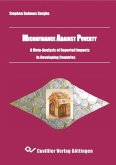Maternal and child health issues remain central to national and global health policies.
Among the eight Millennium Development Goals (MDGs) that were adopted by the 189
members of the United Nations (UN) in 2000, at least four are directly related to maternal
and child health care. Consequently, this dissertation seeks to provide some insight by
investigating three main areas of maternal and child health concerns. Firstly, we examine the
factors driving the high under-five mortality rate with emphasis on supply side variables
with public goods characteristics such as road infrastructure and nurse-per-population. It is
envisaged that access to and utilization of allopathic care will reduce under-five mortality.
Secondly, the study investigates the socio-economic and supply side factors influencing the
demand for particular health providers’ services. Thus conditional on childhood sickness, we
investigate the type of health facility that parents or caregivers demand for children aged
under-five years and the extent to which consumers are satisfied with health providers. In
recent times, health insurance is considered an effective mechanism for inducing the demand
for appropriate health care. If women in the reproductive age own health insurance, their
own health and that of their children will improve and inherently, a reduction in under-five
mortality. Thirdly, the study also explores the factors influencing a woman’s decision to
participate in health insurance and also investigates the socio-economic determinants of
household’s collective insurance decision.
To achieve the above objectives, 531 women (aged 15-49) who had at least one live
birth between 2002 and 2007 were interviewed using stratified random sampling technique
in three Districts in Ghana between October 2007 and February 2008. Methodologically, a
mix of discrete choice and duration models are employed to address the objectives.
Using the Weibull parametric model; the study reveals that health inputs such as the
utilization of antenatal care, childhood vaccination and Insecticide (mosquito) Treated
Bednets are significant in curbing under-five mortality in Ghana. Supply side inputs
particularly nurse-per-population and road infrastructure were statistically significant and
inversely related to under-five mortality. Conversely, multiple births and higher order births
are positively associated with under-five mortality. Household income had a puzzling
positive relationship with under-five mortality, albeit weakly significant.
In the case of the demand for a given provider’s services conditional on childhood
sickness, multinomial choice model is utilized. In addition, the ordered logit model is used to
investigate the impact of the choice of a given providers’ services on consumer satisfaction
of health care. The study reveals that household income is positively and significantly
related to the demand for private medical care. In fact, the effect of income on private
medical care is quadratic in nature. In the case of mothers who took their children to
pharmacy shops, traditional healers and resorted to self treatment, the impact of income was
less pronounced. Waiting time at the health facility which denotes opportunity cost was
consistently and inversely related to the demand for private medical care, faith healing and
self treatment. More importantly, supply side variables such as hospital-bed-per population
and road infrastructure are significant predictors of the demand for private health care.
After controlling for other covariates, subscribers of private health care are
approximately 12 percentage points more satisfied than those who subscribe to public health
care. This suggests that the quality of care in private health facilities outweighs that of public
health delivery. Provider characteristics particularly distance and waiting time were found to
be inversely and significantly related to consumer satisfaction. In all, there are lower levels
of satisfaction associated with the use of alternative health care providers. An important
policy recommendation of this finding is that there is the tendency for allopathic care to
increase at the expense of self treatment and traditional or faith healing as the quality of both
private and public health care improves over time.
Using binary logit model, the study found that supply side factors particularly health
inputs via availability of nurses and proximity (distance) are significant determinants of a
woman’s propensity to participate in health insurance. In terms of the household collective
insurance decision, the fractional logit model was employed. At the household level, the
study finds that nurse-per-population and distance to the nearest health facility were
consistently and inversely related to the number of household members insured.
The study concludes unequivocally that increasing physical infrastructure such as
tarred roads and health inputs such as nurses and hospital beds will increase the demand for
modern health care and reduce the risk of under-five mortality. Given that the level of
existing physical infrastructure (tarred roads) is inadequate, health care policies should
urgently focus on increasing the level of public spending on physical and material
infrastructure in order to achieve significant reductions in under-five mortality.
Dieser Download kann aus rechtlichen Gründen nur mit Rechnungsadresse in A, B, BG, CY, CZ, D, DK, EW, E, FIN, F, GR, HR, H, IRL, I, LT, L, LR, M, NL, PL, P, R, S, SLO, SK ausgeliefert werden.









